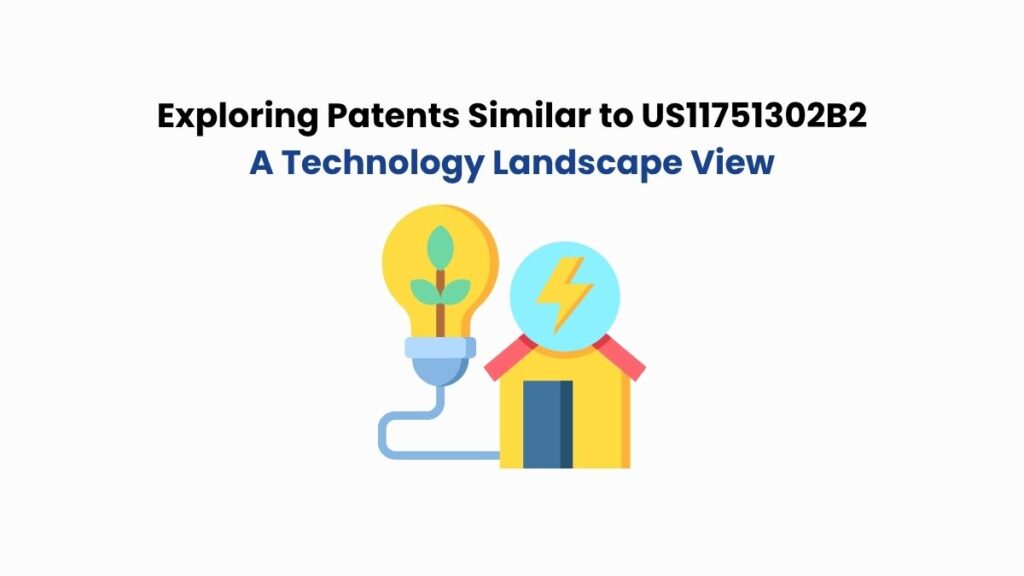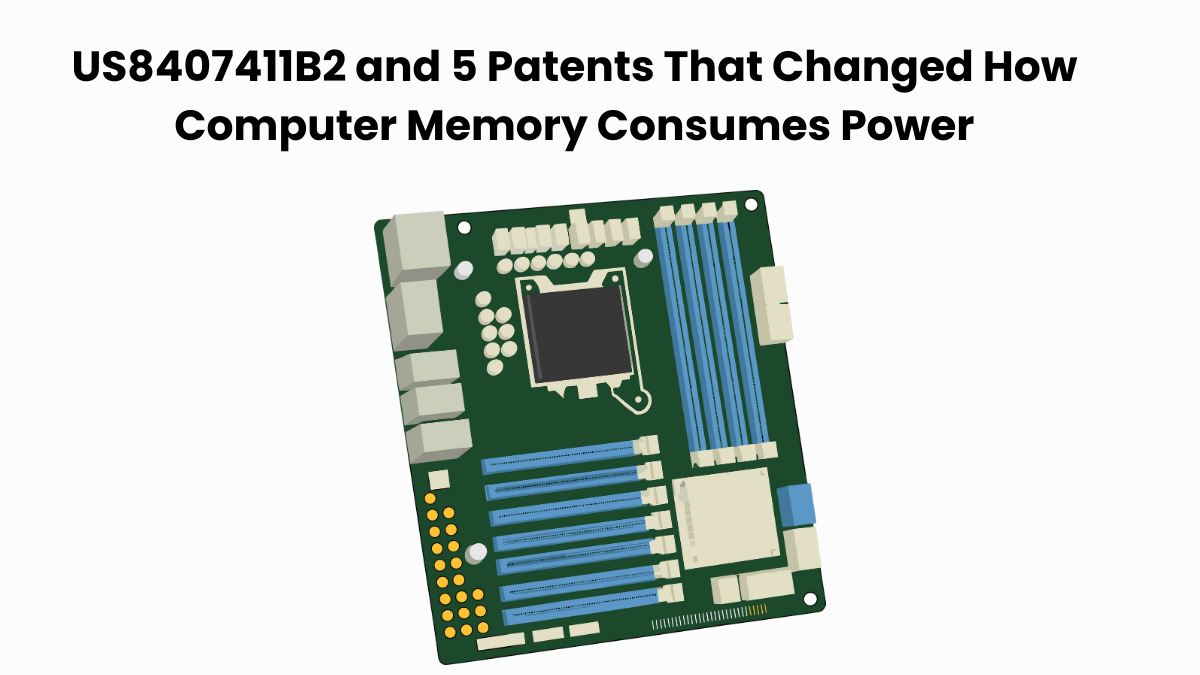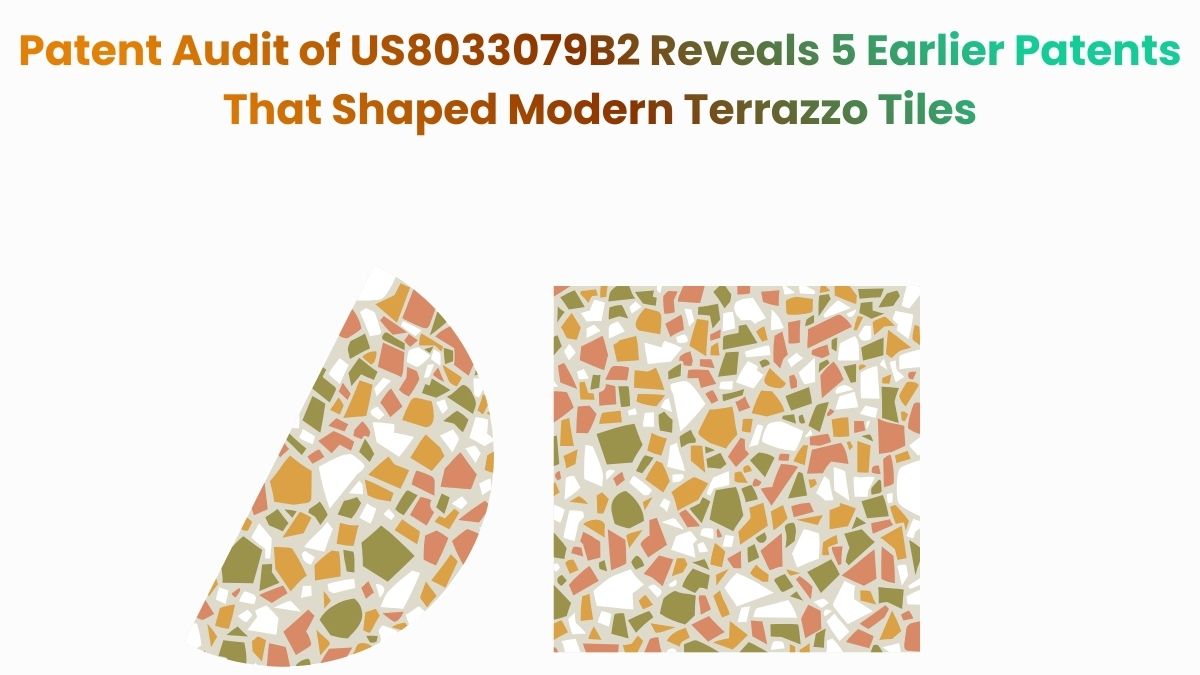Some patents quietly serve niche applications. Others, like US11751302B2, stand out for capturing core ideas that shape broader industry trends.
Recently, this patent has drawn renewed attention following its mention in the case AGS Lighting Management LLC v. Jesco Lighting Group, LLC, a brief legal note that hints at its growing relevance in the smart lighting and control systems sector. Rather than delving into the litigation itself, this article focuses on something far more actionable: uncovering related technologies through patent analytics.
Using the Global Patent Search (GPS) tool, we examine a set of patents that share overlapping architectural elements or functional similarities with US11751302B2.
Whether you’re an IP strategist, tech innovator, or someone tracking the evolution of lighting control protocols, this data-backed deep dive offers a unique look at how interconnected innovations really are.
But first, let’s understand what the subject patent is all about.
Understanding Patent US11751302B2
US11751302B2 discloses a modular linear LED lighting system capable of adjusting both color temperature and luminance through a smart driver-switch assembly. The design enables users to select between multiple preset lighting conditions (e.g., 3000K, 3500K, 4000K) and easily scale the fixture length without compromising light uniformity or efficiency. This system is particularly adaptable for commercial and architectural settings where lighting needs may change over time or vary across environments.
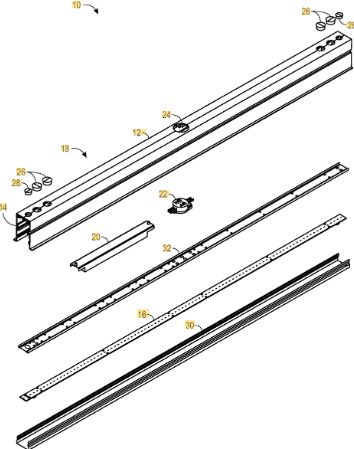
Source: US11751302B2
Its key features include
#1. Dual LED arrays with independent color temperatures: A first and second linear arrangement of LEDs, each emitting different color temperatures, that can operate independently or in combination.
#2. Switch assembly for color and luminance control: A switch mechanism allows users to select between LED arrays or split power for blended lighting, while another switch adjusts current output to control brightness.
#3. Modular scaling via interconnectable units: Lighting modules can be connected end-to-end with proportionally scaled driver outputs and LED quantities, maintaining uniform light characteristics across varied lengths.
#4. Consistent light output through current calibration: The driver circuits automatically scale and distribute current to ensure each LED receives the appropriate power, delivering even luminance regardless of system size.
This patent’s emphasis on modularity, scalability, and precise control over LED performance highlights features that may overlap with competing lighting technologies. Let’s look at what the GPS tool shows.
A similar modular structure appears in US9050929B2, which also uses extended LED assemblies with consistent power regulation to maintain uniform illumination across connected lighting segments.
Similar Patents As US11751302B2
To explore the innovation landscape surrounding US11751302B2, we ran the patent through the Global Patent Search tool. Below is a quick glimpse of the GPS tool in working.
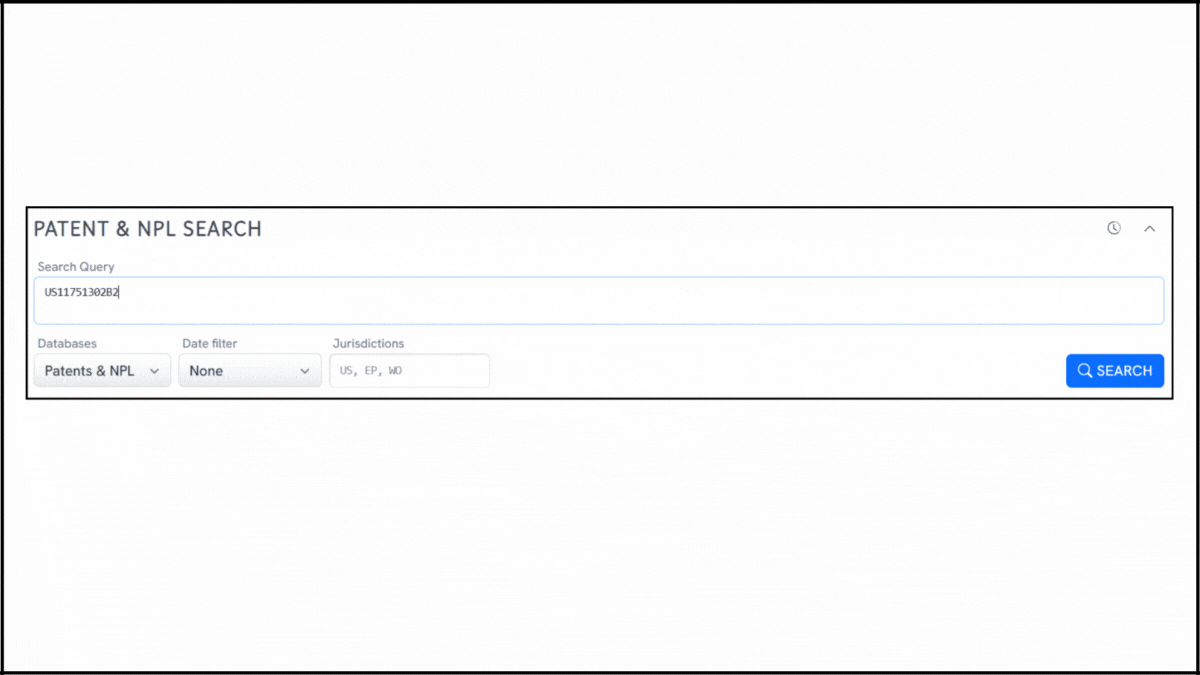
Source: Global Patent Search
This analysis surfaced a list of related patents that share technical similarities in design, functionality, or control architecture. Below, we highlight five of these references that reflect comparable concepts in modular LED lighting systems and luminance control. These examples offer a broader perspective on how similar challenges have been addressed across different inventions.
#1. JP2011044270A
This Japanese patent JP2011044270A, published in 2011, contributes a foundational idea to the landscape of modular LED systems, specifically focused on achieving uniform brightness in multi-row LED arrays through intelligent current regulation and modular connectivity.

Source: GPS
What this patent introduces to the landscape?
1. Current control at the module level: The patent describes LED boards where a central constant current circuit ensures that each LED sequence receives a balanced power supply. This reduces brightness inconsistencies caused by wiring differences, a significant issue in long linear light configurations.
2. Linear LED layouts for expandable installations: LED arrays are arranged in a linear direction, supporting use cases like ceiling lights or showcases. The system enables serial connections of multiple modules, offering flexibility in installation length and layout.
3. Thermal management through distributed design: Each module handles its own heat output, which supports more reliable operation in physically extended lighting environments, a practical design concern in real-world deployments.
4. Attention to electrical consistency: The patent details how minimizing variation in wiring and circuit paths helps maintain even light volume across modules, crucial for consistent lighting performance in modular arrays.
How it connects to US11751302B2?
US 11751302 B2 focuses on a modular LED lighting system with switch-controlled adjustments for both color temperature and luminance. While JP2011044270A does not mention color tuning, it reinforces the core electrical and architectural logic of modular, scalable lighting systems, particularly:
- Uniform current delivery
- Linear LED arrangement
- Module-based scalability
- Installation flexibility
Why this matters?
Understanding this earlier work helps frame US11751302B2 not as an isolated breakthrough, but as part of a broader evolution in LED fixture design, one that incrementally solves for power distribution, modularity, and user control.
LED control principles similar to those in US11630375B2 show how driver circuits regulate current to stabilize luminance across multi-LED configurations.
#2. JP2012243547A
This Japanese patent JP2012243547A addresses a well-known challenge in linear LED systems: maintaining consistent light output across an extended array of LEDs, particularly when individual LED performance can vary. The proposed solution introduces independent dimming circuits aligned with each LED group, allowing precise brightness control throughout the length of the fixture.

Source: GPS
What this patent adds to the landscape?
1. Segmented dimming architecture: The system features multiple dimming units, each with its own dimming circuit, aligned with corresponding LED groups. This architecture allows for independent control over brightness along the length of the lighting device.
2. Customizable light uniformity: By driving each segment individually, the system can compensate for LED performance differences or length-based light falloff, resulting in uniform brightness from end to end.
3. Scalability across lengths: The linear light source is designed for flexible manufacturing in various lengths. Each section’s independent control ensures that consistency is maintained regardless of size.
4. Precision power management: A centralized power-control unit sends signals to each dimming circuit through a cabling system, coordinating illumination across all modules seamlessly.
How it connects to US11751302B2?
While US 11751302 B2 introduces switch-based control over color temperature and luminance in modular fixtures, JP 2012243547 A provides useful precedent for the independent regulation of LED segments, specifically for achieving uniform brightness across long fixtures. Both patents explore modularity, current control, and flexible system design, albeit with different emphases (one on switching, the other on dimming).
Why this matters?
JP2012243547A builds technical credibility around the modular, segment-wise management of LED arrays, supporting the broader trend toward adaptive, customizable linear lighting systems.
#3. US2003011538A1
This early U.S. patent, US2003011538A1, outlines a flexible framework for modular linear lighting systems. It utilizes LED arrays, with a focus on programmability, modularity, and adaptability across various applications. It lays down principles that would become increasingly relevant in modern LED lighting, especially in environments requiring scalable control and varied lighting effects.
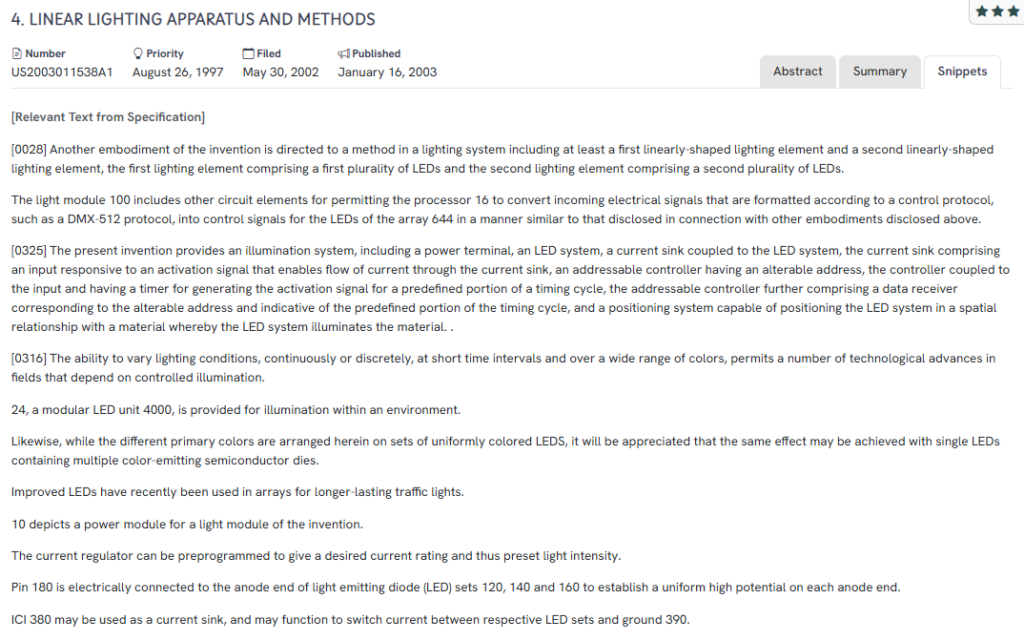
Source: GPS
What this patent adds to the landscape?
1. Modular lighting elements with control logic: Describes LED-based lighting elements that can function independently or as part of a networked lighting system. Each module includes its own controller for generating specific lighting effects.
2. Color and temporal lighting effects: Introduces the use of analog and pulse-width modulation (PWM) signals to control brightness and color changes over time. This adds a layer of programmability not typically seen in early linear lighting systems.
3. Addressable and standalone units: Modules may be configured as standalone units or as addressable nodes in a larger system, making it easy to coordinate lighting effects across multiple connected elements.
4. Structural flexibility for different applications: The invention envisions various configurations: linear, curvilinear, panel, or even 3D arrays, supporting interior and exterior use cases, from architectural lighting to neon replacements.
5. Integration with sensors and positioning systems: The system includes optional sensor integration for dynamic lighting adjustments and mechanical systems for physical positioning of the light arrays, highlighting its use in adaptive environments.
How it connects to US11751302B2?
US2003011538A1 sets the foundational groundwork for many of the modular and programmable concepts that are refined in US11751302B2. While it focuses more on lighting effects, control signals, and system flexibility, both patents share key ideas around:
- Modular LED units
- Programmable or adjustable lighting outputs
- Electrical and mechanical expandability
- Control architectures for varied use environments
US11751302B2 builds on this by tightening the focus on controlled luminance and color temperature, scaling consistency, and standardized module interfaces for practical architectural deployment.
Why this matters?
This patent provides historical depth to the innovation context of US11751302B2. It shows that the idea of modular, programmable LED systems was already under exploration two decades ago, albeit with different technical priorities.
The linear LED-channel design in US9549388B2 also depends on calibrated power distribution to keep illumination consistent along extended lengths, echoing the scaling logic in US11751302B2.
#4. KR20140014782A
This Korean patent, KR20140014782A, presents a lighting system designed to simplify luminance control in modular LED arrays. The key feature is a centralized control system that manages current delivery to individual LED modules based on stored target illumination values. The goal is to achieve uniform brightness across variable-length installations without the need to swap out modules.
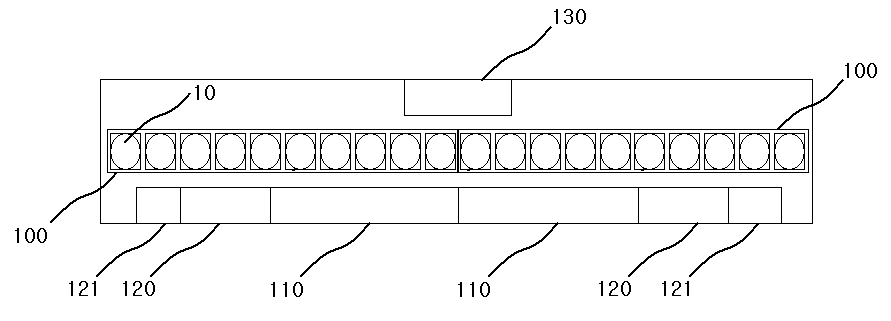
Source: KR20140014782A
What this patent adds to the landscape?
1. Centralized brightness control: A main controller regulates an illumination controller, which adjusts current levels to each LED module according to preset target values. This architecture supports precise luminance management without requiring module replacement.
2. Memory-based current calibration: The system includes a memory unit that stores driving current values for each module, allowing predefined luminance profiles to be reused and ensuring consistent brightness across the system.
3. Longitudinal uniformity across arrays: LED modules are aligned in rows and configured to maintain uniform light distribution over long fixtures, even as the physical length of the system changes.
4. Simplified user operation: The design allows users to adjust lighting levels easily by selecting predefined intensity settings, avoiding the need for complex manual recalibration.
5. Inspection-based calibration support: The invention mentions a testing stage with a light meter that traverses the length of the fixture to measure light intensity, ensuring the system can self-validate its luminance consistency.
How it connects to US11751302B2?
KR20140014782A offers technical context for several elements of US11751302B2, particularly in the areas of:
- Controlled luminance output through regulated current supply
- Modular LED architecture with scalable fixture length
- System-level management of LED behavior based on preconfigured logic
While US11751302B2 introduces switch-based color temperature control and more detailed modular scaling (with extender ports and driver negotiation), both systems aim to solve the challenge of uniform light output across variable fixture lengths, a shared concern in advanced LED installations.
Why this matters?
This patent underscores how multiple global efforts have converged on similar challenges in LED lighting: luminance control, modular scalability, and ease of operation.
#5. EP3764747A1
This European patent, EP3764747A1, describes a sophisticated linear LED lighting system featuring multi-channel pulse width modulation (PWM) control, constant current modules, and three-wire connectivity. It focuses on scalable control and precise lighting across a series of connected modules, offering a fine-grained solution for dynamic lighting environments.
Source: EP3764747A1
What this patent adds to the landscape?
1. PWM-based multi-channel control: The system utilizes a dedicated PWM controller for each influencing variable (e.g., brightness, color temperature), providing fine-tuned control over each channel within every light source module.
2. Constant current modules per LED segment: Each light source module operates with an embedded constant current source, ensuring that voltage degradation or distance doesn’t compromise light quality along the chain of connected modules.
3. Serial connectivity with control signal integrity: Control data is transmitted along a control line shared by all modules, and the system is designed to mitigate signal weakening across long distances, ensuring synchronized behavior even in large-scale installations.
4. Dynamic adjustment of light characteristics: By adjusting the timing and duty cycles of PWM signals, the system can dynamically manipulate brightness and emulate different color temperatures, even across monochrome LEDs.
5. Two-channel module structure: Each light source module can independently control two lighting channels, offering modular adaptability without requiring external dimmers or manual adjustments.
How it connects to US11751302B2?
EP3764747A1 aligns closely with the goals and system design of US11751302B2, particularly:
- Distributed control across modular LED elements
- Use of embedded current control to ensure consistent luminance
- System scalability via interconnectable modules
- Precision tuning of brightness and color
Where EP3764747A1 emphasizes signal-based PWM control for brightness and color management, US11751302B2 integrates physical switches and current calibration logic to achieve similar control from a user-facing interface. Both patents show how linear lighting systems have evolved toward modular intelligence and consistent performance.
Why this matters?
EP3764747A1 adds a modern, technically advanced example to the innovation context of US11751302B2. Its use of channel-based PWM control and constant current assurance across modules reflects the current state-of-the-art in linear LED design.
How to Find Related Patents Using Global Patent Search?
Understanding the broader innovation landscape around a patent can be crucial for product development, competitive research, or identifying overlapping technologies. The Global Patent Search tool simplifies this process by helping users trace technically similar inventions across jurisdictions and timeframes. Here’s how GPS enhances the discovery process:
1. Enter the patent number into GPS: The tool automatically converts the patent number into a natural language AI-based query, which power users can further edit to include custom keywords or technical phrasing relevant to their goals.

2. Explore conceptual snippets: GPS presents detailed snippets, showing where technical features from the target patent appear within other patent filings.
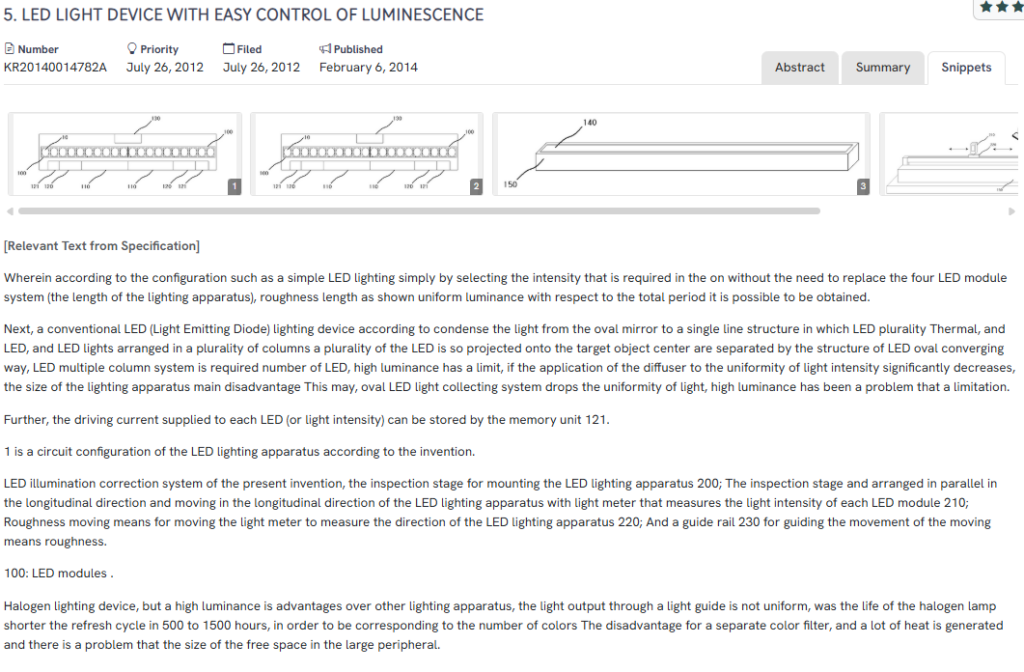
3. Identify related inventions: The tool surfaces patents with similar architecture, control systems, or functional goals, helping users discover earlier designs or alternative approaches to the same technical problem.
4. Streamline research across fields: Whether exploring electronics, software, or lighting systems, GPS enables a faster and more informed understanding of technological ecosystems.
With these capabilities, Global Patent Search empowers professionals to explore innovation pathways and uncover meaningful technical relationships across the patent landscape.
Disclaimer: The information provided in this article is for informational purposes only and should not be considered legal advice. The related patent references mentioned are preliminary results from the Global Patent Search tool and do not guarantee legal significance. For a comprehensive related patent analysis, we recommend conducting a detailed search using GPS or consulting a patent attorney.

